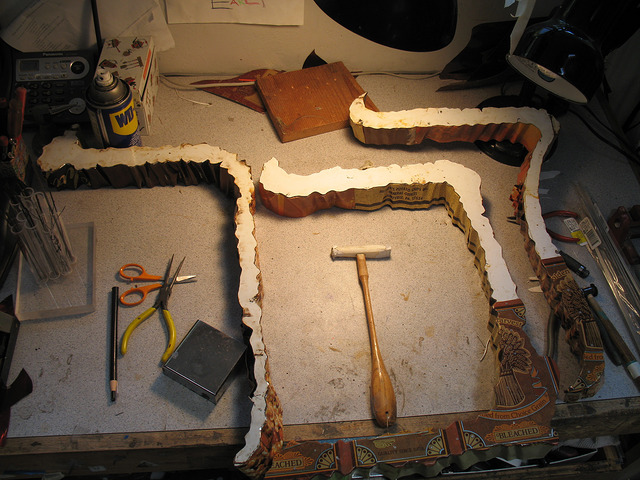Blight: World Hunger
Blight-World Hunger is part of the 10 Modern Plagues. In a time of abundant food production, world hunger is still a problem. It is estimated that one billion people go to bed hungry. Even here in the United States segments of our society do not have enough to eat. Inner city areas are often referred to as a food desert.
Blight-World Hunger is constructed from tin cans with images of grains like wheat, popcorn, rice and flour.
Single letters in Hebrew for the word "blight" are withered and skinny as if damaged by plant disease or drought.
Dimensions for Blight- World Hunger: 32”ht. x 47” w. x 6” d. (including the wilted plants)
Materials: Recycled tin cans
Installation: Each letter hangs on a nail on the wall with a bracket on the back or a simple keyhole for a nail.
Shipping for exhibition: A custom box for shipping is compact and lightweight while protecting each letter. The wilted plants come out for shipping. Below is a close-up view of the top. The grass inserts into the top so it is removable for shipping.
The Idea Behind Blight: World Hunger
While world hunger can be caused by crop failure, I am told that the world currently produces enough food to feed our population. The issues of food distribution and logistics become a critical issue. In the first world, 30% of food produced goes in the trash. In the third world, 30% of food never makes it to markets because of food distribution problems.
Color photo of wheat with stunted growth due to drought (above.) Poor farming practices, civil unrest, violence, climate change and international hostility seriously impact the possibility for people to grow their own food.
Wheat and Grass in the Nature
I cut a number of different grasses from my backyard to study the growth structure of the plants. It is amazing how similar all grasses are in their structure, yet they are different. Wheat, and rice two major sources of food are both a "grass structure."
Close-up view on the side
The lettering on the side says Blight- World Hunger. In this image you can see the images on the tins of wheat, and popcorn (both grains.) The sides were constructed first and the top was added, and wrapped over the side edge.
In the Studio Working on Blight: World Hunger
Below are images of Blight: World Hunger in progress in the studio. The photo on the right is the bottom edge. I used many tins that had images of grains which seems very appropriate at the time...even an obvious choice.
The reality is that I spend hours looking for the right choice of images....hours, and hours pouring through 1,000's of tins.
The letters were constructed from layers of recycled tin cans which was really challenging because I wanted the shape to be so irregular.
The sides were done first, then the top layers was attached and wrapped over the top edge.
Studying the structure of grass in my studio. Every time I tried to make another piece of grass, I got better. A couple of weeks of practice takes patience.
Sometimes the greatest challenge is deciding which tins to use, and getting the images printed on the tin can to fit on the irregular form without mistakes. Most of the time I only have a few tins with images suitable for the theme.
If I make a mistake there is not second chance. Measure twice, cut once is a guiding principle.














